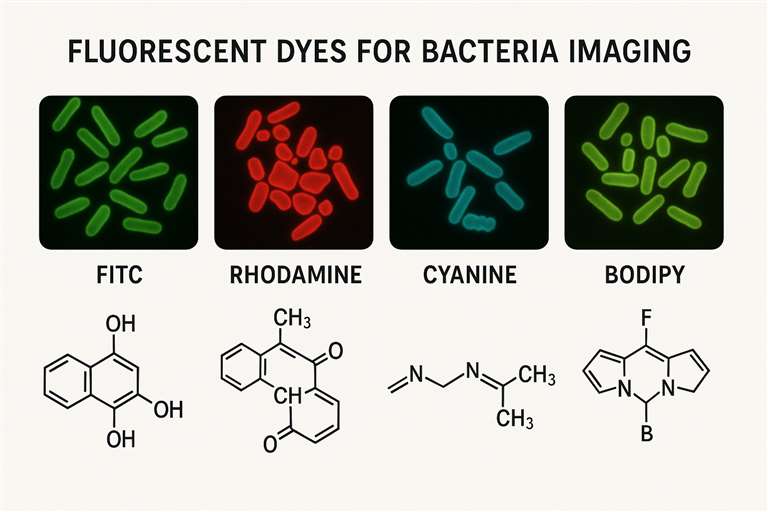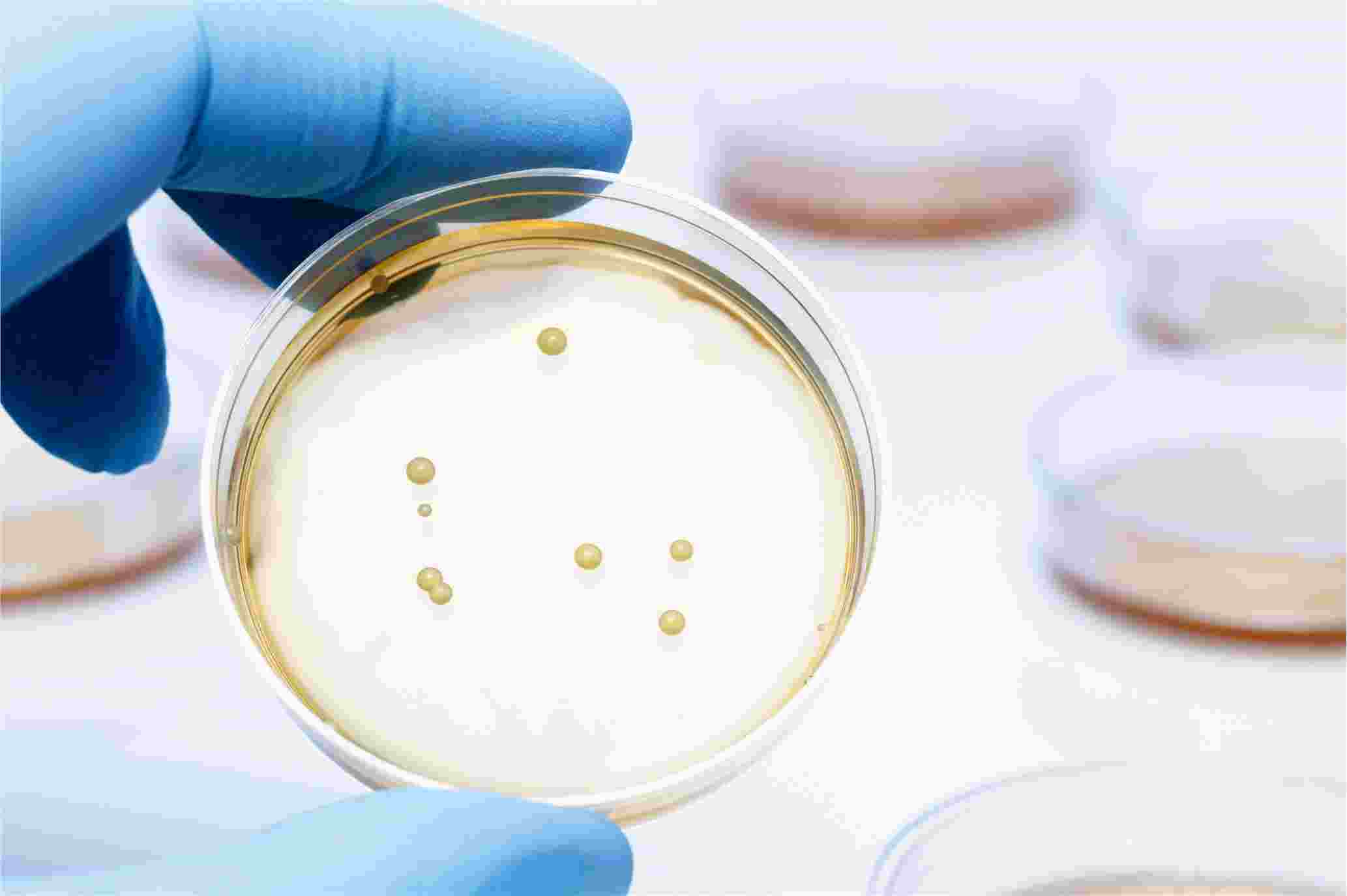Bacteria Imaging
BOC Sciences provides comprehensive solutions of fluorescent dyes and fluorescent probes for research institutions and industrial users. We possess mature capabilities in probe design and synthesis, covering multi-target imaging needs such as cell membranes, cell walls, nucleic acids, and metabolic activity. These are applicable in scenarios including live/dead bacteria identification, biomembrane detection, mixed microbial system analysis, and animal infection models. Combined with a rigorous quality control system and a professional technical support team, BOC Sciences not only offers imaging reagents with high purity and stability, but also commits to supporting customers throughout the entire process—from reagent screening to imaging optimization—boosting efficient advancement in microbiological research and antimicrobial drug development.

Technical Challenges in Bacterial Imaging
Complex Cell Wall Structure
Bacterial cell walls are structurally complex and vary significantly between species, making it difficult for conventional dyes to effectively penetrate. We offer a range of dyes with excellent permeability and imaging probes optimized for different bacterial structures to ensure labeling efficiency and image quality.High Background Interference
Severe background noise interferes with the specificity and resolution of bacterial imaging. Our fluorescent probes feature high targeting capability and optimized fluorescence properties, enabling clear imaging with low background and high signal-to-noise ratio.Photobleaching and Cellular Damage
Prolonged imaging may cause fluorescence signal decay and cellular damage, affecting experimental stability. The dyes we provide have outstanding photostability and low phototoxicity, making them suitable for long-term, high-frequency live bacterial imaging.Biocompatibility Considerations
Probes may interfere with bacterial physiology, making biocompatibility a key factor. We carefully select dye systems with low toxicity and high biocompatibility, balancing imaging performance with the preservation of bacterial activity.
Solutions for Fluorescent Dyes and Probes from BOC Sciences
In the field of bacterial imaging, we address key challenges such as low cell wall permeability, large interspecies differences, and low signal-to-noise ratio, providing high-quality fluorescent tools required from basic research to applied development. Our product portfolio includes a wide range of classical and novel fluorescent dyes, such as FITC, Rhodamine, Cy series, BODIPY derivatives, and NIR near-infrared dyes, characterized by high quantum yield, good photostability, and low autofluorescence background. In addition, we offer various functional fluorescent probes including membrane potential probes, reactive oxygen species probes, metal ion probes, and specifically labeled antibody/aptamer-conjugated probes, fulfilling multi-dimensional imaging needs related to bacterial metabolism, structure, and function.
General Fluorescent Dye Series
Suitable for routine staining and background visualization, featuring good cell permeability and stability, including but not limited to:
- FITC series
- Rhodamine derivatives (e.g., TRITC, TAMRA)
- Cyanine series (Cy3, Cy5, Cy7)
- BODIPY dyes
Targeted Bacterial Imaging Probes
BOC Sciences has developed a variety of functional fluorescent probes that enable specific labeling of bacterial subcellular structures, metabolic activity, or strain differentiation:
- Membrane potential probes
- Live/dead bacterial dyes
- Probes targeting lipopolysaccharide/peptidoglycan
- Reactive oxygen species (ROS) fluorescent probes
- Metabolic pathway-targeted probes
Customized Fluorescent Probe Services
To meet special customer requirements, BOC Sciences offers custom dye solutions based on bacterial type, target molecule, wavelength requirements, and conjugated molecule:
- Probe molecule design and synthesis optimization
- Multi-site modification of dye molecules
- Adjustment of hydrophobicity/hydrophilicity to enhance imaging efficiency
- Biotin/azide/alkyne labeling for click chemistry conjugation
Advanced Fluorescent Platform for Bacteria Imaging
BOC Sciences has built an advanced fluorescent probe platform that integrates in-house design, synthesis, and functional optimization capabilities. It covers multiple types of probes targeting bacterial cell membranes, cell walls, nucleic acids, and metabolic activity, suitable for multi-dimensional imaging needs from basic microbiology to in vivo infection models. This platform provides efficient and visualized solutions for scientific research and drug development.
| Probe Type | Target | Primary Function | Application Example | Key Advantages |
| Membrane Probes | Bacterial cell membrane | Label membrane integrity, monitor changes in permeability | Antibacterial screening, viability assays | Fast staining, low cytotoxicity, suitable for live-cell imaging |
| Live/Dead Bacterial Dual Stains | DNA and membrane integrity | Differentiate live and dead bacteria using SYTO 9 & PI | Biofilm activity mapping, sterilization studies | Clear discrimination, dual-channel high-contrast imaging |
| Cell Wall-Targeting Probes | Peptidoglycan, cell wall synthesis sites | Detect structural changes, track division and antibiotic action | Vancomycin-BODIPY imaging, β-lactam response studies | High specificity, ideal for Gram-positive bacteria, dynamic visualization |
| Nucleic Acid Dyes | DNA/RNA | Label bacterial nucleic acids for quantification and localization | Bacterial density measurement, microbiome sample staining | Multicolor options, compatible with flow cytometry and confocal imaging |
| Metabolic Activity Probes | Enzyme activity, pH, ROS, etc. | Monitor bacterial metabolism and stress responses | Drug response analysis, resistance mechanism studies | Real-time reflection of physiological changes, multiple metabolic targets |
| Multiplexed Fluorescent Probes | Multiple structural targets | Simultaneous imaging of multiple bacterial species or targets | Gut microbiome studies, oral flora analysis | Strong multichannel compatibility, clear species differentiation |
| In Vivo Imaging Probes (NIR) | Whole-body bacterial signal (infection sites) | Real-time monitoring of bacterial infection in animal models | Mouse infection models, antimicrobial efficacy validation | High tissue penetration, low background noise, ideal for in vivo imaging |
Multidimensional Quality Analysis to Verify Fluorescence Performance
BOC Sciences consistently regards product quality as its core competitiveness. In the development and production of fluorescent dyes and probes, a rigorous quality control system has been established to ensure high purity, stability, and reproducibility for every batch. Through the following multidimensional quality management system, we provide reliable, high-quality fluorescent dyes and probes for researchers and industrial users, ensuring the accuracy and reproducibility of experimental data. Specific measures include:
- Raw Material Selection: All raw materials used for the synthesis of dyes and probes are sourced from certified high-quality suppliers to ensure chemical purity and batch-to-batch consistency of starting materials.
- Synthesis Process Monitoring: Standardized process flows and automated reaction control systems are employed to monitor reactions in real time, reduce the generation of by-products, and ensure batch stability.
- High-Performance Analytical Verification: Before shipment, all products must undergo comprehensive analysis including HPLC, LC-MS, NMR, UV-Vis, and fluorescence spectroscopy to evaluate purity, structure, and optical properties.
- Functional Activity Verification: All fluorescent probes undergo biological activity validation under specific application conditions (e.g., bacterial staining, membrane permeability, signal intensity) to ensure performance in cellular or tissue imaging.
- Standardized Storage and Transportation: Products are packaged using light-proof, low-temperature, and moisture-proof materials, coupled with temperature-controlled transportation services to preserve the stability and activity of fluorescent probes to the greatest extent.
Advanced Analytical Platform
- Confocal Laser Scanning Microscope (CLSM)
- Flow Cytometer
- Fluorescence Microscope
- Multiphoton Microscope
- High Content Screening (HCS)
- In Vivo Imaging System (IVIS)
- Fluorescence Spectrophotometer
- Laser Confocal Microspectral System
- Super-Resolution Microscopes (STED, SIM, PALM/STORM)
- Fluorescent Plate Reader
- Imaging Flow Cytometer
- Live Cell Imaging System
Broad Applications of Bacterial Imaging Solutions
BOC Sciences' fluorescent dyes and probe products, characterized by high sensitivity, high specificity, and excellent biocompatibility, are widely compatible with various bacterial imaging scenarios. Whether in basic research or applied development, these solutions address diverse needs in visualizing bacterial behavior, dynamic monitoring, and mechanism analysis, efficiently supporting scientific research and drug development.

Antibacterial Drug Screening
In antibacterial drug development, rapidly evaluating candidate compounds' effects on bacteria is critical. Fluorescent probes targeting bacterial structures (e.g., Vancomycin-BODIPY) provided by BOC Sciences enable intuitive visualization of drug efficacy, allowing researchers to observe processes such as cell wall damage, membrane integrity changes, or bacterial death in real time, thereby accelerating drug screening and dose optimization.
Monoculture Imaging
For common monoculture bacterial studies in laboratories, BOC Sciences offers highly selective dyes and fluorescence-compatible probes suitable for phenotype observation, cell division tracking, and metabolic status evaluation. These dyes are easy to use, compatible with various microscopy systems, and significantly enhance data acquisition efficiency and imaging precision, providing robust support for fundamental microbiological research.
Polymicrobial or Microecological System Imaging
In studies involving complex microbial community structures and dynamic changes, multicolor fluorescence imaging is particularly important. BOC Sciences provides multi-wavelength fluorescent dye combinations to distinguish different strains, monitor interspecies interactions, and analyze microbial responses to external stimuli. These are suitable for applications in microbiome research, gut flora analysis, and environmental microbiology.
In Vivo Animal Bacterial Infection Models
Studying bacterial infection pathways, colonization sites, and immune responses in animal models requires high-penetration probes with near-infrared (NIR) properties. BOC Sciences has developed specialized in vivo imaging probes (e.g., IR-783 derivatives) capable of real-time imaging without sacrificing animals, greatly improving the interpretability and efficiency of animal experimental data.
Biofilm Imaging
Bacterial biofilms play a critical role in antibiotic resistance and chronic infection development. BOC Sciences provides live/dead dual-staining dyes (e.g., SYTO 9 and PI combination) that accurately distinguish physiological states of bacteria within biofilms, supporting research on biofilm formation mechanisms and sensitivity to various cleaning agents and antimicrobials. These are indispensable tools for biofilm imaging studies.
FAQs About Bacteria Imaging
What types of fluorescent probes does BOC Sciences offer for bacterial imaging?
We offer various fluorescent probes targeting cell membranes, cell walls, nucleic acids, and metabolic activities, suitable for live/dead bacterial detection, biofilm imaging, mixed bacterial typing, and in vivo infection models.
Do you support custom probes for specific bacterial species?
Yes. We can custom synthesize fluorescent probes or dyes based on the bacterial species information, target requirements, and imaging platforms provided by clients.
Are the offered probes suitable for in vivo animal infection models?
Yes. We provide near-infrared (NIR) fluorescent probes with good tissue penetration and low background signal, suitable for live imaging experiments in animals such as mice.
Which imaging platforms are your dyes compatible with?
Our probes are compatible with mainstream imaging platforms including confocal microscopes, flow cytometers, fluorescence microscopes, and in vivo imaging systems.
How do you verify the activity and imaging performance of probes?
All probes are validated for bacterial imaging before shipment, including testing for fluorescence intensity, targeting specificity, signal-to-noise ratio, and imaging clarity.
Do you provide technical documentation for the probes?
Yes. We provide complete product documentation (COA/MSDS) and can also offer application suggestions, experimental guidance, and references upon request.
Is there a minimum order quantity?
We offer flexible packaging specifications, ranging from small-scale experimental reagent grade to gram-scale R&D/pilot-grade quantities to meet various customer needs.
Is multichannel imaging supported?
Yes. We offer multicolor fluorescent probes with clearly defined excitation/emission wavelength ranges for multichannel imaging and multi-strain colocalization experiments.
What are the storage and transportation conditions for fluorescent probes?
All probes are packaged to protect from light, moisture, and heat, with some requiring storage at -20°C. We also provide temperature-controlled shipping services.
Online Inquiry

